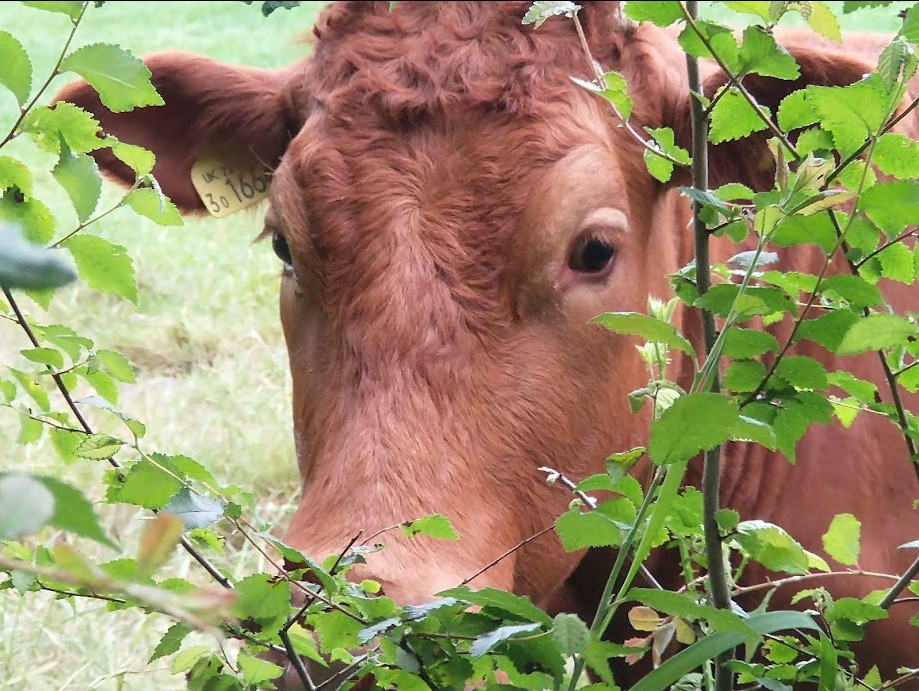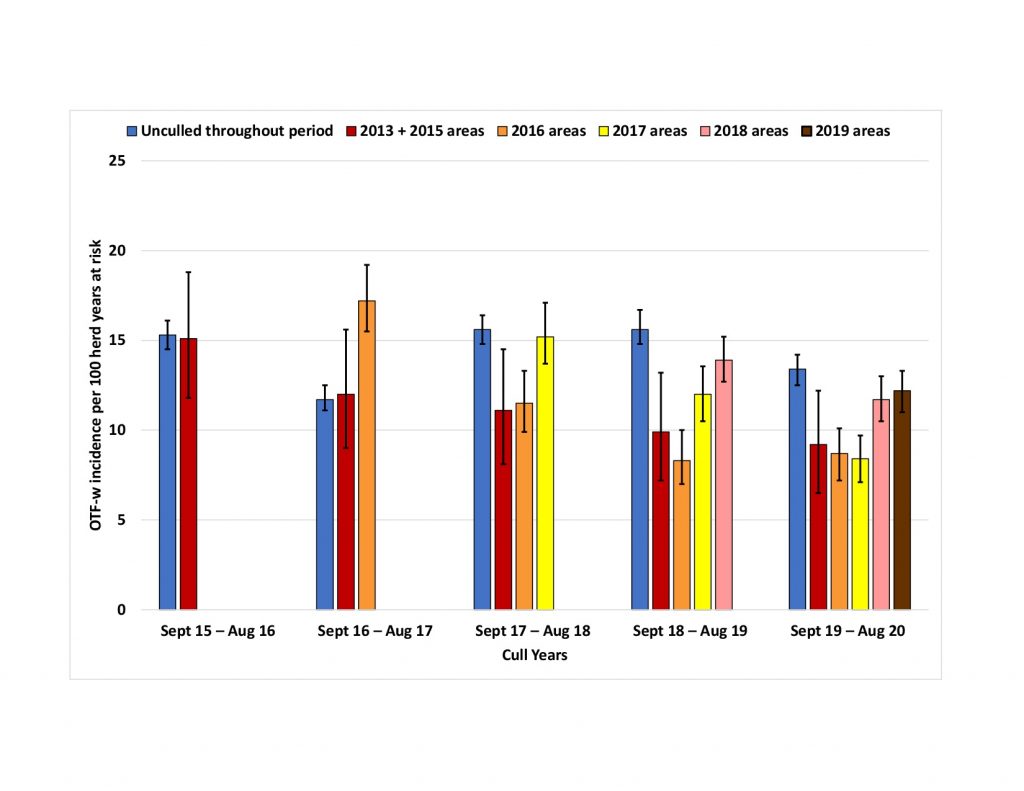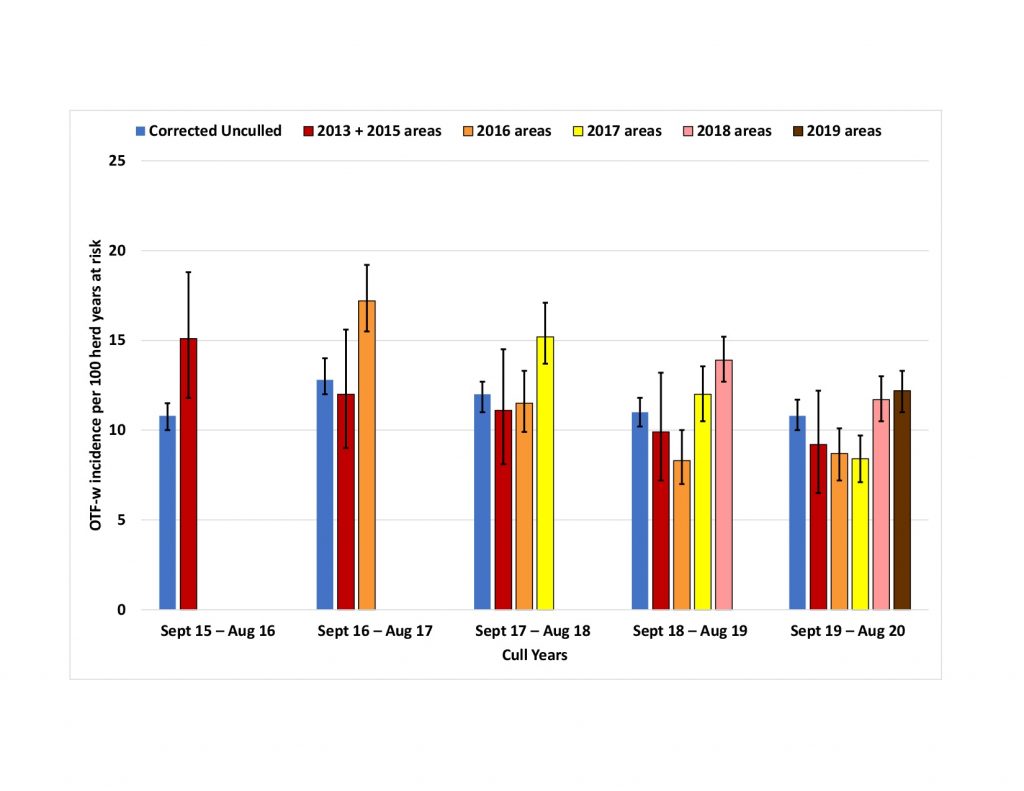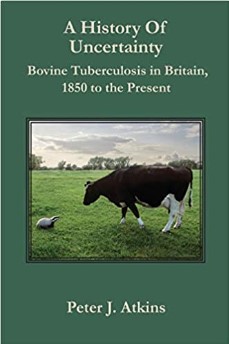Retracing the history of the supposed role of badgers in the cattle bTB epidemic shows that this is far from settled science.
by Tom Langton
Uncertainty has surrounded the coronavirus pandemic and its control over the last five months. But over the last fifty years, uncertainty has hindered the tackling of a bovine tuberculosis (bTB) disease epidemic in England. BTB is still spreading across central and northern England and into the east, with recent increase in Scotland too. There is urgent need to review the way in which modelling has been used to make vital decisions of huge cost and consequence.
There is concern that misleading policy-based science has emerged and is being perpetuated as the result of a relatively small group of academics, civil servants and vested interests mishandling uncertainty. On 5 March 2020, new plans to expand badger killing over many more years were announced. With more cull areas than ever in 2020, the need to reconcile the policy with facts has never been more urgent. In May 2020 badger slaughter was again approved, with further mass badger culling in September and October, when up to 50,000 mostly healthy badgers will be killed or injured.
This action is based not on clear factual evidence, but opinion on inscrutable models that are not safe reference. Public access to data has been made difficult, delayed or prevented. Are applied decisions of great magnitude safe when the science on which they are based has evolved from data heavily adjusted by choices, ideas and assumptions that may or may not be correct?
Uncertainty and the scientist
Many scientists deal with uncertainty for a living. They consider past events and evidence as a way of assessing how best to take forward investigation and experimentation. They must do so with care. They cannot treat weak evidence or hypothesis as fact, or over-reach in ‘grey’ areas, nor cling to convenient theories. Their role is to consider both sides of any argument and constantly assess the risks of pursuing different approaches.
When there is pressure from vested interests, those giving and receiving scientific findings and interpretations can both fall foul of, or take advantage of ambiguity, mistake, misjudgement and manipulations. Scientists must be very careful when being asked to find an answer in order to satisfy a particular paymaster, where ‘pressure to please’ may often be the temptation.
Drawn to a ‘High Impact’ challenge
Some researchers may be drawn to ‘high impact’ work on uncertainty, where the stakes (of life and death) are high and it is here also that well-funded research may be found, (1) Modellers, who work with complexities of uncertainty by deploying data to find patterns, are in a forum where death and ambiguity often perpetuate. In this often lavishly funded arena, the risks can be high. Get it right and you’re the hero, wrong and detected, you may be the villain.
Generally, most people hate uncertainty and crave certainty. Those in business want a constant background to manufacture, grow and trade. Sometimes people just want uncertainty to be over for good or bad, so they can ‘get on with their lives’. Even if this means arriving at a ‘new normal’ where the rules have changed and with unknown risk. They may be prepared to achieve this by adopting a ‘possible’ truth, hoping for better understanding down the line. So for most, uncertainty can be hated, avoided, or manipulated according to needs and motivations, and sometimes in subtle ways that cannot be detected by the onlooker. It is vital to be alert to how uncertainty is handled and presented, especially when you are a scientist.
Dealing with uncertainty
A good researcher remains open-minded, open to debate, cautious with knowledge and modest in their claims and comments. They greet being wrong through new discovery or hindsight with good grace and a smile, as an essential occupational hazard, and not as failure. Sometimes in science, incorrect assumptions or findings get lost or swept away after a researcher has retired or passed on. Being wrong can be a legacy that emerges later, and ideally never matters that much. Or one that exposes a tragedy.
Generally, researchers just want to test scientific concepts to advance knowledge. Decision makers and their advisers can cause damage, either through lack of understanding of the data and what to do with it or by having political motives in a particular analysis, to support a specific policy.
Uncertainty and Bovine TB
Researchers need to be the ones who interpret science and help everyone else to travel in the best direction. If they stray, they may be part of a very destructive force. They can be influential and gain the confidence of decision makers, pushed forwards to promote a decision based more on policy than fact. And if they are partial, wrong, or slow to declare oversights and misrepresentations, damage may be deep and long lasting.
The uncertainty in bTB has never been whether badger, deer, cow and many other mammals can contract and pass the bacteria to each other. When kept confined closely together this will happen. The uncertainty is whether it happens frequently outdoors in our rural environment.
The next uncertainty is whether there is adequate evidence that reducing badger (or deer or fox) numbers can contribute to reducing bTB herd breakdowns. There are those who say the modelling of data from the Randomised Badger Culling Trials (RBCT 1998-2005) areas gives signs that with badgers, it might. There are those who find the evidence too uncontrolled and speculative. And there are those in the middle who find that it simply remains inconclusive.
Those in the middle may also have an opinion either way. Either that badger culling is indefensible on the evidence, or that culling might be ‘worth a go’. The compounded uncertainty creates a broad spectrum of views on the use of public funds to kill large numbers of mostly healthy badgers. An iconic protected species that has only partially recovered status in the UK since its protection by law. This is the primary controversy of badger culling in bTB control.
Despite appearances, from a legal standpoint Defra now occupy more of the middle ground than most realise, seeking de-stabilished badger populations at around 30% of a guesstimated starting density. They have held on to, yet now have substantially drifted away from RBCT science as a guide. Since 2016, Defra have brought in prolonged or “supplementary” badger culling (SBC). This approach perpetuates badger killings to keep numbers down following four years of intensive culls depleting up to 90% of a population, with the hope of ‘keeping’ any theoretical benefit, whether or not it actually exists. Yet this is with recent (2019) senior scientific advice that there is no way of actually detecting any direct evidence of supplementary culling working at all and recognising that science even warns (2) that it might, in reality, increase the rate of herd bTB breakdowns. Poison not medicine.
Much has been revealed in emails and evidence in the High Court during Judicial challenges to SBC since 2017. Defra now runs the policy predominantly on the personal/individual opinions of government experts and not on clear referenced science (see below). There is, however, year-on-year growing evidence that the problem is in the cattle herd, with strong evidence of cow to badger transmission. But badger to cow transmission remains circumstantial and based on substantial levels of uncertainty.
Defra has promised a strategy at the High Court to achieve the impossible; that they will ‘adapt to and learn from’ any outcomes with respect to SBC. But only when hundreds of thousands of badgers have been shot across much of West and Central England and £billions of industry compensation paid out over decades, around the un-checkable approach and the spreading disease. This is a massive gamble.
Current approach is high risk and not evidence-based.
Defra now relies heavily upon the tentative modelling and comparisons of effects by the Animal Plant and Health Agency (APHA) in modelling (Brunton et al 2017, Downs et al 2019) (3. & 4.) and ignoring of real time trends in cull areas. This adds up to equivocal ‘guesstimating’ in any consideration of policy performance (McGill & Jones 2019) (5). It is not hard to pick up on the small number of studies, the relatively small sample sizes and the variety of uncontrolled and confounding variables in the government-funded models that have been constantly used by Defra Ministers and industry to definitively claim progress in the face of empirical evidence on the ground.
As the famous British statistician George Box reminds us in his paper published in The Journal of the American Statistical Association in 1976: “All models are wrong, but some are useful”.
“Since all models are wrong the scientist cannot obtain a “correct” one by excessive elaboration. On the contrary following William of Occam he should seek an economical description of natural phenomena. Just as the ability to devise simple but evocative models is the signature of the great scientist so over-elaboration and overparameterization is often the mark of mediocrity.”
Even basic analysis carries elements of simple modelling in its procedure. It is just that as modelling hangs on multiple assumptions or adjustments, especially when dealing with complex biological systems, that any administration trusting the results is calling upon the opinion of scientists as opposed to the facts. This is where danger lies.
How useful has the badger and bTB modelling work really been, or has its effect been destructive? What we do know about badger cull modelling is that with the levels of ambiguity and uncertainty in its parameters no plane would take off, no ship would sail, no pill would be prescribed and no lockdown safely lifted. Models need careful handling (6).
The making of uncertainty: where it all went wrong?
We now have the long delayed Defra response (7) to the not-so-independent and limited in scope ‘self-assessment’ review by government-funded scientists chaired by Oxford’s Universities Charles Godfray (8). And so it seems reasonable to refresh our memory on the more fundamental points that surround the current bTB controversies. Taking us back some 25 years to views, advice and decisions made surrounding the uncertainty of dealing with bTB in cows.
STAGE 1. The Kreb’s Group; The Independent Scientific Group on Cattle TB (ISG) of largely Oxford scientists made a crucial statement in its 1997 report (9). It suggested that newly bTB infected calves and young cattle were infrequently infective. At the time there was no real means to prove this – it is now an arguably irresponsible suggestion. It may have been the cattle vet industry view at the time, but this clear and apparently innocent statement has failed both science and the nation for a generation.
The point was not just the shortness or unpredictability of infectiousness at any one time in a calf’s first year. But that the young cows, soon sent to market and moved to new herds might pass it on, before or after leaving and during short, undetected and often transitory bursts of infectiousness. These may be brought on randomly, by being transported, handling by a dealer, mixing with other stock, arrival in new farm conditions or other forms of stress.
A calf or young cow need not exhibit obvious disease symptoms to pass bTB on from non-visible lesions. Yet it can contribute, together with other categories of diseased stock (traded or kept in proximity) for the reproductive R number (that we are now all so familiar with) to rise above 1. How safe might social distancing be for cows with their extremely powerful lungs shooting air and bacteria many metres? The cattle vet suggestion at the time was that a ‘hidden bTB reservoir’ was not in cattle but from another environmental source, and that source must be badgers, causing 90% + of breakdowns. The Kreb’s Group oversight of 1997 is the primary problem from which many onward wrong turns have sprouted. It reinforced the assumption to a generation of researchers, farmers and vets, that badgers were the significant hidden reservoir, when it was unclear if they were involved to any significant degree.
In doing this, the Kreb’s report looked past painstaking volumes of research from the first half of the last century by John Francis and others. Particularly work on the hidden reservoir of infected cows failing to test positive under the skin test in what was, by the 1990’s, an accelerated livestock industry. Anergic cows, those pregnant, under certain medication or carrying other disease, or too young or too old are often not detected by the test. Particularly overlooked was the hazard of passing of bTB from mother to calf and through the mixing and feeding of pooled unpasteurized infected milk to newborns after calving.
STAGE 2. The ISG presenting RBCT results in 2007 (10) made a decision not to use all cattle skin test Reactor results following SICCT testing in their main study findings, but just those from cows with Visible Lesions (VL) at slaughter. The lack of significance of the All Reactors results in terms of badger culling reducing new bTB herd breakdowns was put to one side, and the VL sub-set that offered a significant discovery was pushed forwards. This was even though inconclusive reactors (a now redundant term) were assumed also to have had bTB infection.
There had, in truth been two results, or one divided in half. Half the results said ‘significant’, but ‘all’ results said ‘not significant’. This partisan selection of data represents a second substantive decision in ‘badger blame’. The issue was reduced to a sense that the dichotomy was ‘strange’ but that was all. The modellers advice was that to choose one result over the other was acceptable, enabling any true uncertainty to disappear in the rear-view mirror. Modellers are in charge, it’s their model not yours.
The result chosen, beyond claiming badger culling was associated with less bTB breakdown was the one that matched one of the main drivers to the study. This was to try to demonstrate a bTB ‘perturbation effect hypothesis’ for bTB and badgers. Put simply badgers moving around and spreading disease. Published before the ISG 2007 report, this may provide an explanation of the above choice of data, selected for drawing conclusions over more uncertainty. It told a neat story, whereas uncertainty might have been wrongly judged as a failed experiment.
STAGE 3. In 2007 the strength of the RBCT hypothesis of badgers spreading bovine TB during culling inside and beyond the periphery of cull areas was strongly questioned by Sir David King (the then Government Chief Scientific Adviser) and his study group (11). They concluded that the perturbation effect was hardly strong enough to show statistical significance. The effect was no more than a theory in need of further validation.
STAGE 4. The RBCT conclusion of involvement of badgers in bTB spread is based upon modelling Visible Lesion-only data in particular ways. An alternative simple and very similar approach (12) suggests that the result of proactive badger culling using VL breakdowns alone is as likely to be insignificant as significant. Such is the uncertainty in modelling. Strong models are reinforced by similar alternative models complementing their conclusions. Further scientific questions arise because of the non-blinded nature of the RBCT- a field trial; any results of such an approach must be handled with extreme caution. Again, uncertainty is an acceptable result of experimentation, even if it does not resolve the question asked.
STAGE 5. Modelling used to justify the start of badger culling in 2013 included two key papers (Donnelly and Hone 2010 and Donnelly and Nouvellet 2013) (13 & 14). The first paper used a model that had been applied to bTB in brushtail possums and cattle in New Zealand. This assumed that infection of badgers from cattle was negligible, something thought then to be highly unlikely and known to be wrong now for many years. This was a substantial oversight. The second paper, with the first paper factored-in, tried to account for the massive disruption of the RBCT by influences from the 2001 Foot and Mouth Disease (FMD) crisis and its aftermath that came along mid-study.
There were two outcomes. In short, one analysis estimated that badgers might be directly responsible for around 5.7 % of bTB herd breakdowns. The other one, this time factoring in the potential FMD distortions, said there was no certainty of an effect (between 0 & 100). It was the 5.7% and not the 0-100% conclusion that was chosen and taken forwards by Defra. The additional modelled leverage here was the assumption that from the modelled 5.7% transmission, there is a 50% effect on onward transmission within cattle herds and hence to breakdowns. This was the tenuous but frequently used 2013 justification that that year unleashed the mass destruction of mostly healthy badgers.
Let’s look at all that in summary:
- Stage 1: Misleading assumption on calf infectiousness.
- Stage 2: 50/50 call on results taken forward.
- Stage 3: Hypothesis as likely to be right as wrong.
- Stage 4: 50/50 call, on result to take forward.
- Stage 5: Incorrect assumption in key model and selective use of results.
That badger culling has no effect on bTB levels in cattle is more likely to be the case, with two epidemiological oversights embellishing the uncertainty.
The point here is not that anyone made deliberate errors or was careless. There is no conspiracy. But that simple small statistical and modelling assumptions with wrong turns, compounded to gain momentum upon which followers have trustingly built rather than questioned
There is no certainty at all that killing badgers can form any part of the answer to the bTB in cattle crisis. But publications based on the RBCT report implied that there was certainty in the results. The approaches taken have misinformed the public and non-specialist professionals and administrators and politicians and have cost the badger dearly.
Were badger culls shown as ineffective by 2019?
More recently, with the Brexit debate raging and the December 2019 General Election taking centre stage, the interest in bovine TB slipped down the ratings of national emergencies. BTB was increasing within central England, partly due to boundary changes, but showing signs of stabilising in Wales (no badger culling) and SW England as gradual introduction of more regular and better testing finally started to limit infection. But overall policy stagnation and failure was matched with results from the first year of Supplementary Culling in Gloucestershire. This is the only place where cull boundaries are reasonably well known, and scrutiny showed a 130% increase in breakdowns in 2018 (15).
With the Defra Chief Scientific Advisor Prof Ian Boyd retiring in June 2019, his leaving note on badger culling (16) did not pretend that it would ever be possible to determine any direct link between badger culling and cattle bTB breakdowns. This is the expert adviser whose keenness (with chief vet Nigel Gibbens) to design and promote supplementary badger culling policy also stated (in disclosed internal Defra e-mails and in navigating around badger legal protection), that “modelling hasn’t served us very well.”
Genomics study; facts or fantasy?
Behind the scenes in the second half of 2019, it was possible to detect a new confidence in APHA and Defra’s Exeter ‘TB Hub’ circle, despite the crushing Gloucestershire Pilot Area 1. failure. A new paper (17) with a long, rocky time in review arrived on 17 December, right underneath the general election result.
This eLife online study uses an approach called Whole Genome Sequencing (WGS) to identify precise genetic identity of bTB strains or spoligotypes. Using methods called Random Forest and Boosted Regression analysis, it reported on estimates of transmission of bTB between cattle and badgers, at and around the government badger study site of Woodchester in Gloucestershire. This is a wooded valley with high density of badgers but few cattle. So few cattle in fact, that the study reached out over 300 sq. km to find genetic data from 124 breakdown cows, to compare with the badgers examined at Woodchester between 2000 to 2011.
The Guardian launched the research findings for Defra (18) with a slightly off-message headline “TB infection from cow to cow more likely than transmission by badger”. In 2019, the headline not matching the story was increasingly noticeable as a misinformation technique on social media. “Transmission occurred almost 10 times more frequently from badgers to cows than from cows to badgers” wrote a Guardian journalist who eagerly tweeted the finding that such long sought-after evidence was ‘indisputable and direct’. When actually it was not.
The WGS study merely assumed transmissions had occurred in a certain sequence when this was factually unclear. Although the WGS in this study can establish a close genetic relationship between bacterium in infected hosts, it cannot provide a nuanced chain of infection at an individual level. The only ever scientifically proven bTB transmission direction is the Cumbrian case of an imported cow from Ireland passing bTB spoligotype 17z to local cows and badgers.
The Defra technique of giving a journalist an exclusive while also priming other cooperative commentators was to follow. Previously, in October 2019, for the delayed release of the four-year analysis of intensive badger culling (19) Defra had coordinated journalists and experts to ‘big up’ yet more dubious APHA modelling. Scientists Krebs, Woodroffe, (Oxford/RBCT) and Woods (Cambridge) commented on how the findings related to their work (20).
Rosie Woodroffe from the Zoological Society of London found merit in carrying on badger culling together with another unblinded field trial. “The really exciting element of the study is the possibility of using its methods to explore whether transmission probabilities vary between areas subjected to vaccination or culling.” Krebs was somewhat more circumspect. “The genetic data demonstrate conclusively that TB is transmitted both from badgers to cattle and from cattle to badgers.”
Prof James Wood, Head Vet at University of Cambridge, (& Godfray Group member) now appears to be a key cheer leader for badger culling within government contractors. He earned himself this front seat in controversy in 2017 by saying (to the delight of Defra and the NFU) on National TV’s primetime Sunday slot Countryfile, that the Brunton 2017 paper suggested that badger culling was working.
Wood thought the genomics was no less than an “elegant piece of science” The results were “interesting in their quantification, albeit with some uncertainty, of what has been generally accepted to be the case scientifically for some time (although not by everyone around the polarised policy space).” So there is his restatement of uncertainty and generality, pushed as a theory that uncertainty is down to policy and people, not the science.
In summary one can observe in public, scientists with uncertain research findings courting endorsement via more uncertain research. An uncertain journalist finding certainty where it does not exist and a scientist giving expert political advice. This is the bTB and badgers showcase of the uses and abuses of uncertainty.
Uncertainty in the perpetuation of uncertain science for decades
In the 1960’s, the UK reduced bovine TB by around 80% over four years. So why do we have the current impasse in control, notably since bTB spread widely with cattle restocking after Foot and Mouth in 2001? When badger culling began in England in 2013, the figure for any anticipated reduction in new bTB herd breakdowns was naturally questioned. A government group that included Krebs, had decided, using the RBCT as reference, there could be a reduction averaging 16% per year and this was written into policy.
However, the 16% figure was based upon the RBCT study of fiercely escalating bTB epidemic hotspots, where bTB testing had been suspended for a year and where levels of bTB were much higher than average. The lowering in some study areas was the ’modelling-claimed’ slowing of the rate of increase, not an observable decrease at all. All of this was lost on the public.
Given that cattle testing and movement controls are said by cattle vets to be effective, with the supposed net 16% p.a. benefit, after five years bTB would surely be all but gone? Why else would you shoot hundreds of thousands of mostly healthy protected wild animals against the will of the general public and using lots of their money?
Today bTB is embedded in England. It is perpetuating in the High Risk Area of the west of England. Given enhanced testing, some reduction should be expected, as in the Republic of Ireland, who have culled badgers for decades but there is no consistent decline seen. In both countries, bTB languishes at unacceptable levels and despite the high financial, and the (little mentioned) un-monitored animal welfare and environmental cost.
There is still no real measure for what badger or fox or deer culling could contribute, if anything, to bTB control. It’s uncertain. Government policy advisors in England even further covered their backs by saying any ‘benefit’ from removing badgers would vary and might even not happen in many areas. This is how long-term uncertainty in policy becomes self-perpetuating.
So farmers were, and continue to be misled by farming representatives, veterinary bodies, Defra and others pressing-home policy-based modelling as truth. Claiming that an average 16% a year benefit was there to be had. When the true benefit was somewhere between nothing and possibly something. At best, the ‘possible something’ might be less than that modelled from the RBCT pressure-cooker high-density areas. It’s anyone’s guess and undetectable in the manipulation of uncertain science. With a very good chance of not existing at all. Is this any way to proceed?
Finding the disease epidemic exit strategy.
In a crisis, immediate or drawn out, do scientists sometimes let the public down badly or is it always the politicians’ fault? Scientists are human and can be compromised by circumstances and the uncertainties of modelling. Is it just that as human problems get larger, the errors are more noticeable and serious? Are academics more exposed than in the past by modern communications enabling external scrutiny? Hiding things ‘under a carpet’ or college rug is increasingly difficult?
There are today a vast array of farm animal diseases and industries of farm veterinarians and drug suppliers, built up around the intensive meat and dairy production. Much as human densities have rocketed, and livestock movements become cheaper and easier, farm animal numbers have grown with the natural consequence of pathogens finding new opportunities to mutate and proliferate.
How accurately the RBCT model and subsequent modelled extrapolations reflect any reality in bTB control remains a burning biological question. Far from the ‘settled science’ proclaimed by CSA Ian Boyd in 2018, with every twist and turn, the English bovine TB and badgers policy exposes more and more of its weakness, including the runaway train of having no measure of success or failure along the way.
Does Oxbridge hold the solutions and an exit strategy?
Oxford University is at the epicentre of the controversy, having been at the helm of the core work on the role of badgers and bovine TB and judgement around which the mass killing of them has slowly unfolded. Why do universities and related research institutes and agencies playing a role in the UK’s crowded disease investigation businesses ignore science ‘mediocrity’ in the badgers and bTB scandal?
Is it because some players have been bogged down in vaccine investigations that wrongly assumed for decades that bovine TB couldn’t be detected in blood, (which it can in fact) ? Is it because some are close to people who are close to livestock and meat and dairy export interests and lobbying MP’s? Many are funded by Defra who work closely with the NFU, prioritising output and profit. Interests that value badgers as worthless.
Oxford and Cambridge, not to mention Imperial College need to take a long hard look at what is now a ‘Loxbridge’ tarnished bTB triangle and put things right. These are the institutions that have shaped and moulded the place we are in today with bovine TB. But now the hallowed institutions seem to be ‘in too deep’, unable or unwilling to put things right.
Who might be brave enough to begin such an uncomfortable process? Might this be from others close to and around them, might they become more vocal? As with coronavirus, there is a need to look beyond the economic arguments, to work out what is truly sustainable for the health and survival of people, wild and domesticated animals and their environments, and to build away from uncertainty and wrong turns.
The present human struggle with viral disaster should remind us that not openly dealing with wild and domesticated diseases quickly enough, that taking risks and liberties with science and not paying deference to uncertainty may lead to protracted misery and hardship for all in the long run. We can only hope that for now the greatness and wisdom of nations will be judged by the way that pathogens are treated. With accuracy, caution and all due deference to uncertainty. And not to forget, honesty.
References/LINKS
- Bosely Sarah 18th March Neil Ferguson: coronavirus expert who is working on despite symptoms https://www.theguardian.com/world/2020/mar/18/neil-ferguson-coronavirus-expert-who-is-working-on-despite-symptoms?CMP=Share_iOSApp_Other
- Jenkins et al. 2010 https://journals.plos.org/plosone/article?id=10.1371/journal.pone.0009090
- Brunton et al. 2017 https://onlinelibrary.wiley.com/doi/full/10.1002/ece3.3254
- Downs et al 2019 https://www.nature.com/articles/s41598-019-49957-6
- McGill and Jones 2019 https://veterinaryrecord.bmj.com/content/185/22/699
- Ian Sample Coronavirus exposes the problems and pitfalls of modelling https://www.theguardian.com/science/2020/mar/25/coronavirus-exposes-the-problems-and-pitfalls-of-modelling?CMP=Share_iOSApp_Other
- Defra response to Godfray Review 5 March https://www.gov.uk/government/publications/a-strategy-for-achieving-bovine-tuberculosis-free-status-for-england-2018-review-government-response
- Godfray Review Nov 2019 https://www.gov.uk/government/news/review-of-governments-bovine-tb-strategy-published
- Krebs report 1997 http://www.bovinetb.info/docs/krebs.pdf
- ISG Final Report 2007 https://webarchive.nationalarchives.gov.uk/20081108133322/http://www.defra.gov.uk/animalh/tb/isg/pdf/final_report.pdf
- David King Group report http://www.bovinetb.info/docs/RBCT_david_%20king_report.pdf
- Langton 2019 https://juniperpublishers.com/jdvs/pdf/JDVS.MS.ID.555826.pdf
- Donnelly and Hone 2010 https://www.researchgate.net/publication/244933482_Is_There_an_Association_between_Levels_of_Bovine_Tuberculosis_in_Cattle_Herds_and_Badgers
- Donnelly and Nouvellet 2013 http://currents.plos.org/outbreaks/index.html%3Fp=22371.html
- McGill and Jones 2019 https://veterinaryrecord.bmj.com/content/185/22/699
- Ian Boyd note June 2019 https://thebadgercrowd.org/supplementary-badger-culling-sbc-adapting-and-learning-is-impossible-its-official
- Crispell et al 2019 https://elifesciences.org/articles/45833
- GUARDIAN: TB infection from cow to cow more likely than transmission by badger https://www.theguardian.com/uk-news/2019/dec/17/tb-infection-from-cow-to-cow-more-likely-than-transmission-by-badger?CMP=Share_iOSApp_Other
- https://theecologist.org/2019/nov/05/badger-meddling
- Science Media Centre https://www.sciencemediacentre.org/expert-reaction-to-a-study-looking-at-the-transmission-of-tb-between-cattle-and-badgers/
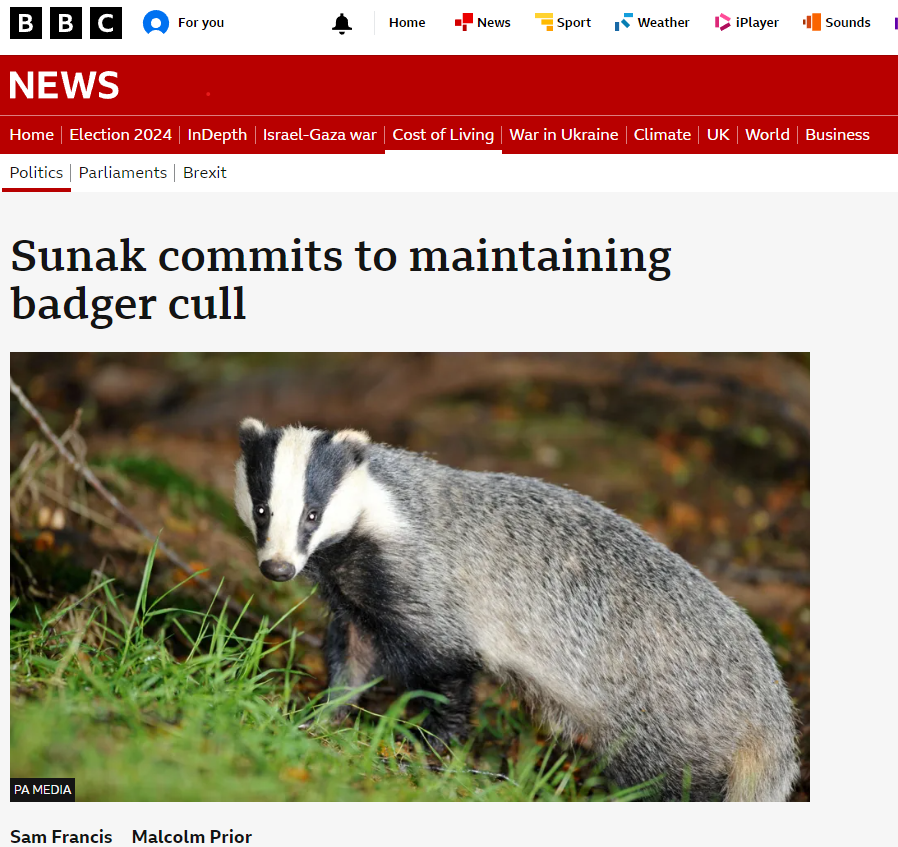


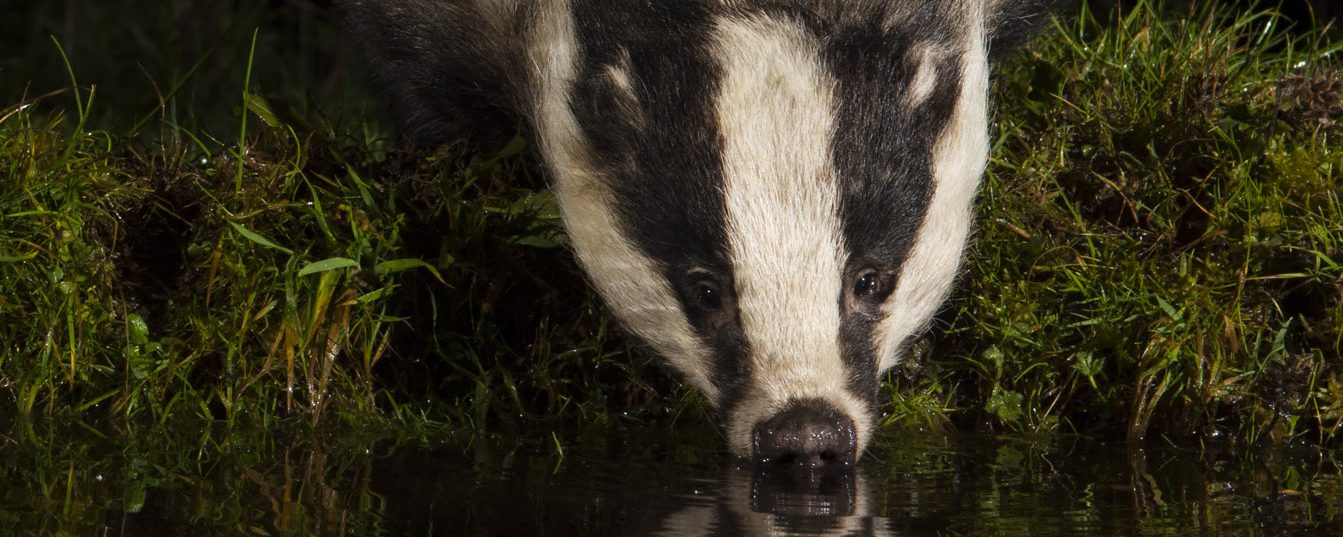
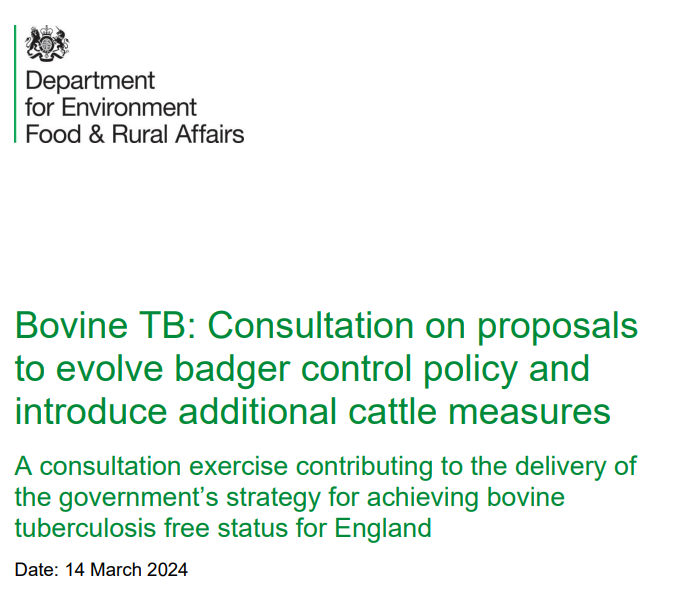

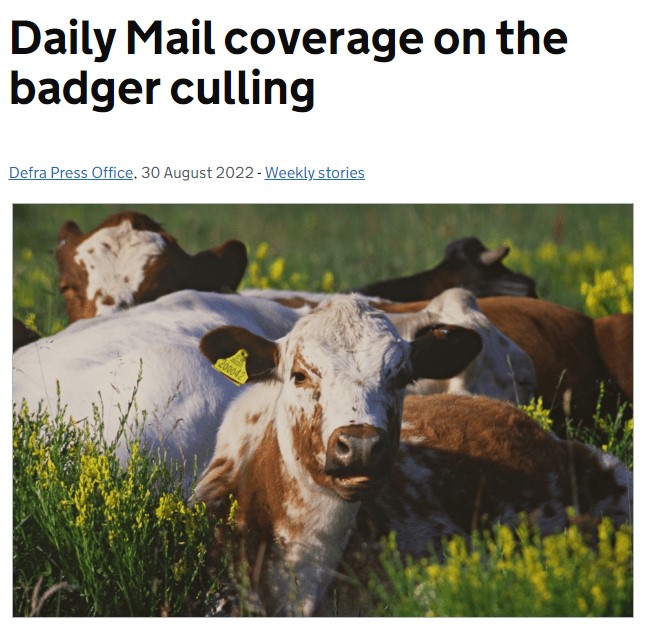 The 30 Aug Defra blog stated:
The 30 Aug Defra blog stated:
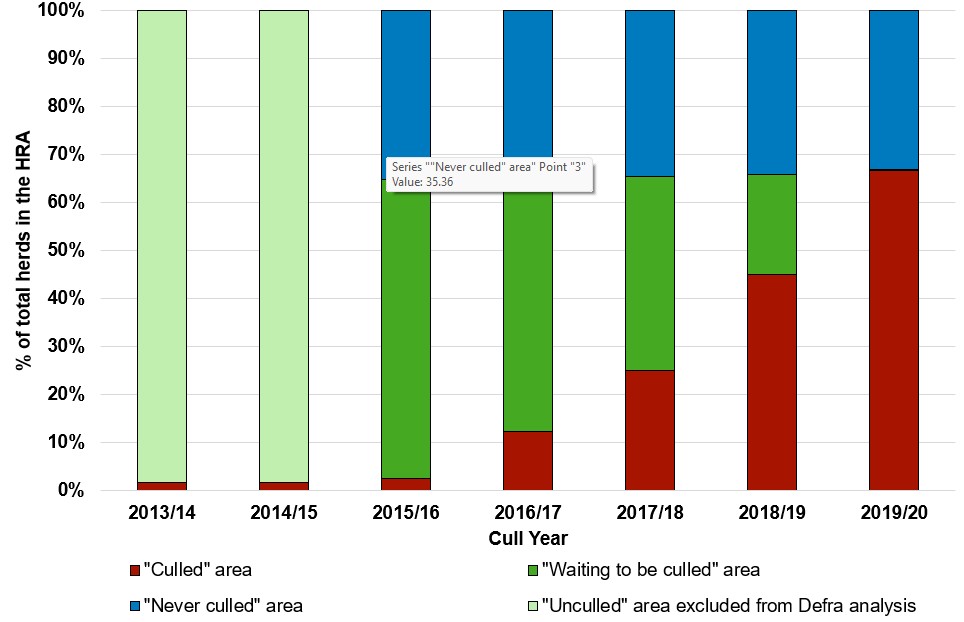 Again, Defra selected a subset of ‘never culled’ badger cull areas to compare with ‘culled’ areas. Why have they done this? Because if you compare ‘all’ the unculled areas with ‘all’ the culled areas, those 26 different statistical models used in Langton et al. fail to find any difference in levels of bTB between them. What is the difference between Defra’s ‘never culled’ data area & Langton et al.’s unculled data area? Well for a start Defra’s never culled area is very much smaller than Langton et al’s unculled area (see figure), about 30% of it in fact. Defra are are comparing only the blue (unculled) and red (culled) area data, but none of the green unculled area data; all area data were used in the Langton et al. analysis. The weakness of Defra’s analysis is their use of a smaller dataset. This could potentially exaggerate any difference between the compared areas. Again, Defra is selectively using data and adding uncertainty to claim a benefit, when impartial analysis using all suitable and available data shows there to be none. Defra’s approach is arguably less appropriate than that of Langton et al.. And of course their analysis is not peer reviewed, i.e. properly checked by independent experts. It is disappointing to see it being published.
Again, Defra selected a subset of ‘never culled’ badger cull areas to compare with ‘culled’ areas. Why have they done this? Because if you compare ‘all’ the unculled areas with ‘all’ the culled areas, those 26 different statistical models used in Langton et al. fail to find any difference in levels of bTB between them. What is the difference between Defra’s ‘never culled’ data area & Langton et al.’s unculled data area? Well for a start Defra’s never culled area is very much smaller than Langton et al’s unculled area (see figure), about 30% of it in fact. Defra are are comparing only the blue (unculled) and red (culled) area data, but none of the green unculled area data; all area data were used in the Langton et al. analysis. The weakness of Defra’s analysis is their use of a smaller dataset. This could potentially exaggerate any difference between the compared areas. Again, Defra is selectively using data and adding uncertainty to claim a benefit, when impartial analysis using all suitable and available data shows there to be none. Defra’s approach is arguably less appropriate than that of Langton et al.. And of course their analysis is not peer reviewed, i.e. properly checked by independent experts. It is disappointing to see it being published.